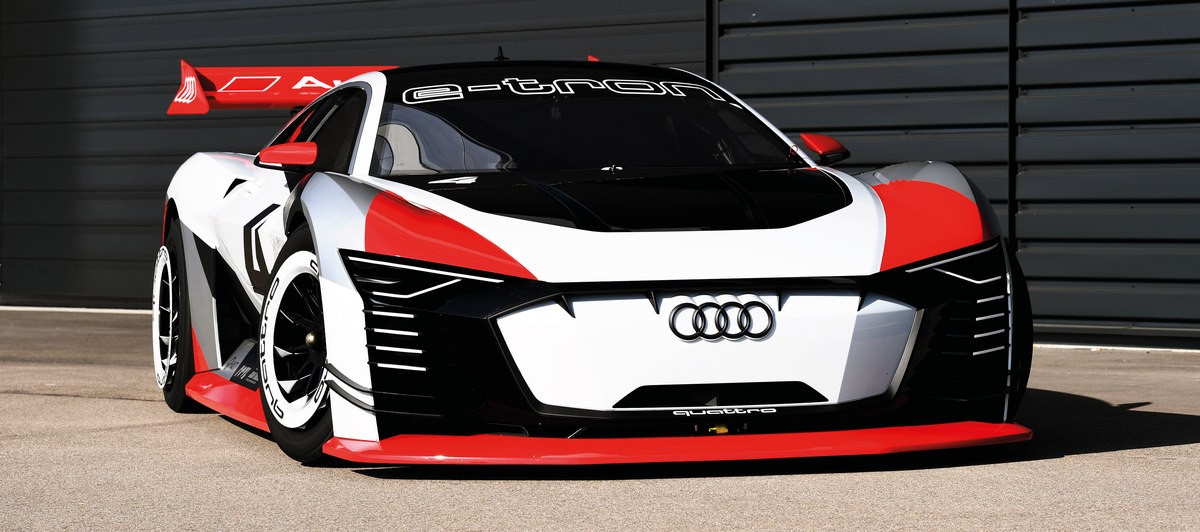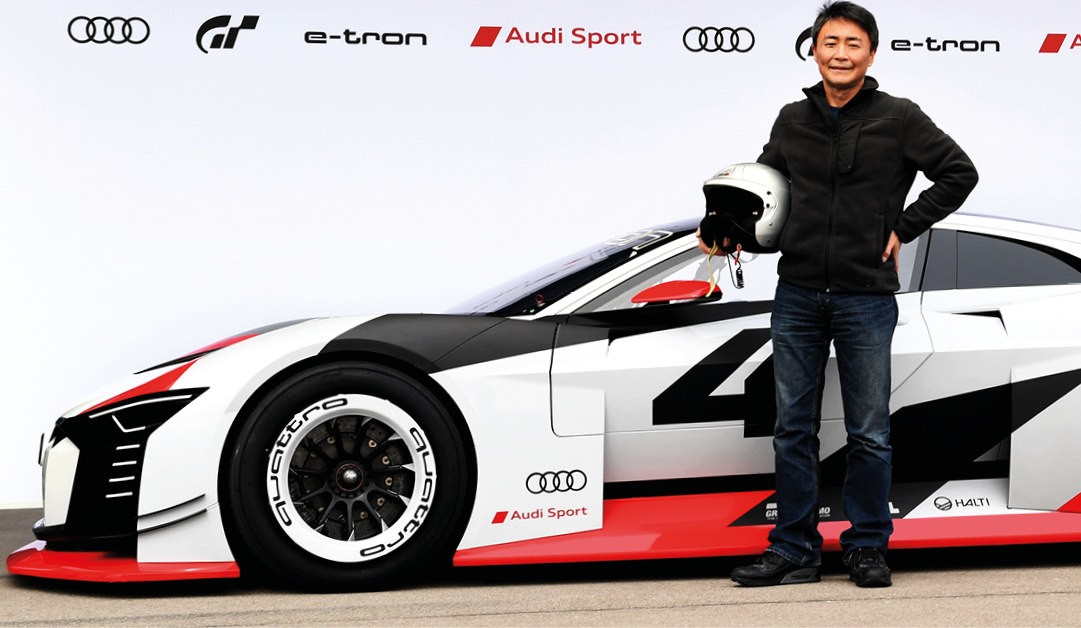
Virtual reality
Audi makes electric mobility a truly emotive experience. For the Gran Turismo race simulation, the brand with the four rings developed the Audi e-tron Vision Gran Turismo. The study not only delivers a powerful virtual performance but is also compelling in fully functional form in the real world.
Birte Mußmann (copy) & Audi Communications Motorsport (photo & video)
Audi has maintained partnerships with gaming companies since the late 1990s. The virtual version of the newcomer, the Audi Vision Gran Turismo, is available in the “Gran Turismo™ Sport” edition for PlayStation 4. In addition to the all-electric version (Audi e-tron Vision Gran Turismo), there is also a hybrid variant (Audi Vision Gran Turismo), which combines a V6 turbo engine with an electric front axle. A visual hallmark setting the models apart is the Singleframe: A black radiator grille graces the hybrid, while this feature is white on the all-electric model. Both the virtual and the real-life concept cars were unveiled on April 9 at the Audi Sport center in Neuburg. It was not just racing pros like Audi Formula E driver Daniel Abt who were on hand to gain a sense of both game usability and track performance; racing enthusiast and Gran Turismo visionary Kazunori Yamauchi, also in attendance, gave the car’s performance and design the thumbs up. Lofty praise, considering the Senior Vice President of Sony Interactive Entertainment Inc. und President of Polyphony Digital Inc. has a reputation as a perfectionist.
The digitalization era is unlocking lots of exciting new possibilities that can be explored virtually. Thanks to technological advances, the relevant hardware and software is capable of generating increasingly detailed worlds of experience. In many areas, including gaming, these developments have smoothed the way for an innovative process of discovery: High-resolution visuals, increasing frame rates, compelling sound and controls that provide haptic feedback blur the boundaries between the virtual and real world. Whoever takes the wheel in a car of their choice as part of the Gran Turismo motorsport game, for instance, gets a pretty accurate idea of what it feels like to be a pro racer on one of the popular tracks. That experience encompasses not only naturalistic color reproduction and lighting conditions but also rendering locations in the minutest detail as well as faithfully reproducing the models’ driving performance, including handling. Players receive visual, auditory and, where appropriate, haptic feedback when overtaking, drifting or running onto the course markers.
With the Audi e-tron Vision Gran Turismo study, the brand with the four rings is closing the gap between the virtual and real world. The study was created within the scope of the Vision Gran Turismo competition, which was initiated to mark the eponymous game’s 15th anniversary. The Audi e-tron Vision Gran Turismo is equipped with permanent all-wheel drive in the form of the all-electric e-tron quattro all-wheel drive with variable power distribution. Three electric motors, each with an output of 200 kilowatts, propel the concept car—two drive the rear axle while the third is responsible for the front axle. System output is 600 kilowatts. With a curb weight of 1,450 kilograms, the electric racing car has a power-to-weight ratio of 2,42 kilowatts per horsepower (1.78 kilograms per horsepower) with 50:50 percent weight distribution between the front and the rear axle. Acceleration from 0 to 100 kilometers per hour is achieved in less than 2.5 seconds. What’s more, this athletic performance is not only limited to the virtual world but can also be experienced for real. In just under a year, the Audi developers and designers have re-engineered the all-electric racing car to be fully functional.
The sporty study’s design is defined by a slim base frame that takes its cue from the shape of the Singleframe grille. In sync with the design idiom, the car sports a coupé-like roof line and powerful horizontal center line that wraps around the body of the Audi e-tron Vision Gran Turismo. Plenty of vents in the hood and wheel arches give the clear-cut composition of the architecture a slightly fragmented look. Sporadic design elements and the coloring echo the legendary Audi 90 quattro IMSA GTO, with which the Four Rings thrilled motorsport fans in the North American IMSA GTO racing series as far back as 1989 with drivers such as Hans-Joachim Stuck, Walter Röhrl, Hurley Haywood and Scott Goodyear.
The Audi e-tron Vision Gran Turismo: Born in the game. Built for the track. Formula E driver Daniel Abt took the wheel in Neuburg.

Fully-electric or hybrid version: This is how the digital version of the race car in the driving simulation "Gran Turismo ™ Sport" looks like.
The extreme conditions in motorsport help generate valuable experience for electric mobility, some of which is also useful for series development. Fully electric models will also play a key role for series in the future. The first fully electric series production model will be ushering in this new Audi era in just a few months.
With its combination of uncompromising lightweight design and quattro drive coupled with a powerful five-cylinder turbo engine, the car was ahead of its time. The Audi e-tron Vision Gran Turismo now transports this visionary character into the 21st century where its alternative drive system reflects the transformation of our mobility, and consequently also of racing—in both the virtual and real world. Its subdued sound may still seem odd in this sporting arena, but it makes up for it in power and dynamism.
The Audi e-tron Vision Gran Turismo as a futuristic race taxi
The fully electric-powered Audi e-tron Vision Gran Turismo made its public debut as a futuristic race taxi at the Formula E race in Rome in April 2018. This marked the premiere of both the concept car and the venue in the all-electric racing series. During the current season, the futuristic race taxi will also be dynamically chauffeuring guests around all the other race locations in Europe. Behind the wheel: former DTM driver Rahel Frey as well as Italy’s 2003, 2004 and 2008 Le Mans winner Rinaldo Capello, and others. Alongside its engagement on the sidelines of Formula E, Audi is also pushing ahead on the racetrack: This season, Audi was the first German carmaker to enter the contest. Audi drivers Daniel Abt and reigning champion Lucas di Grassi are chasing points in the Group’s first all-electric racing car, the Audi e-tron FE04. The Brazilian took second place in Rome, while Abt came in fourth, almost snagging a spot on the podium. It’s not just the season’s results that keep us on the edge of our seats, but also the future of Formula E itself: Starting next season, only one car will be used per driver, eliminating the mandatory change of cars half way through the race. At the same time, the car will boast more power and sprint from zero to 100 kilometers per hour even faster. This is a challenge the Audi team will meet with a new-generation racing car that has already pulled off a compelling performance in initial testing at the Monteblanco circuit in Spain.
